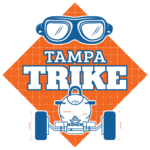Divide and Conquer the Road: Independent steering and lean functions
Here we are showing the independent steering and lean functionality of the custom trikes. When the vehicle is stationary, turning the steering wheel to a lock position does not change vehicle lean position.
When throttle is added, the adult trike will lean automatically to the current appropriate lean position. Here the rear wheel track is inside the inside front wheel track. This will vary with speed and steering radius. Twice in a neighborhood corner, the rear wheel track has been so far inside that the outside front wheel lifted off the road surface. Repeating this has never been tried.
The king pin and shock relationship can be seen as well. The kingpin is the shock shaft. The production trike has two shocks per wheel. This is mainly done for structural strength of the front beam assembly and for separation of the steering and suppression casters. Each shock has two ports. Lower one for filling with oil. The second is for air exhaust during filling. In the application, there are four shock ports per wheel. There are at least five (5) ways these ports can be piped. Exterior flow control/check valves can be utilized in a manual or auto adjustment.
What is fun about the way the three wheel vehicle trike conquers a corner is that one has the familiar automotive type control yet it feels more like a small airplane. The driver mostly feels compression. Visual is the main cornering clue. It is unknown what the maximum cornering speed indicator would be. It may be just common sense or the po-po.

